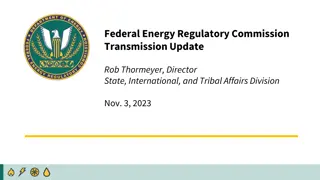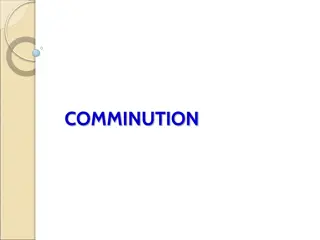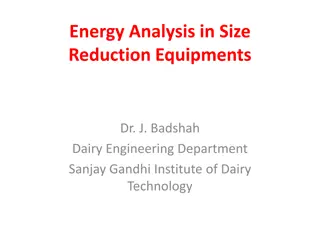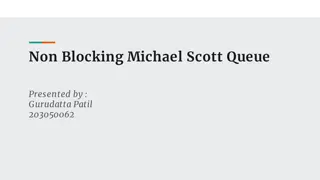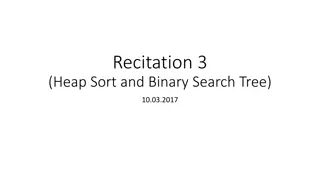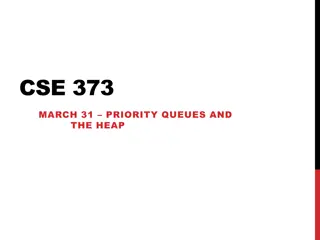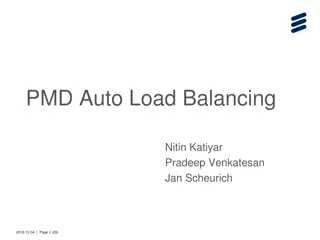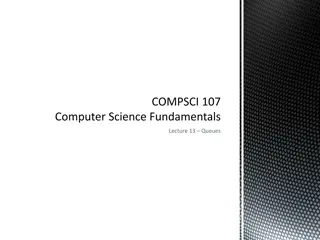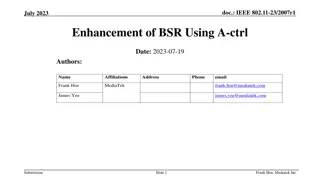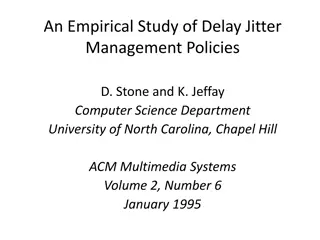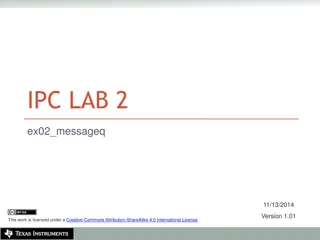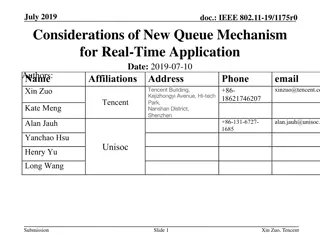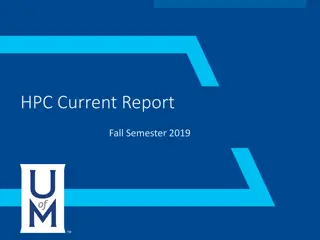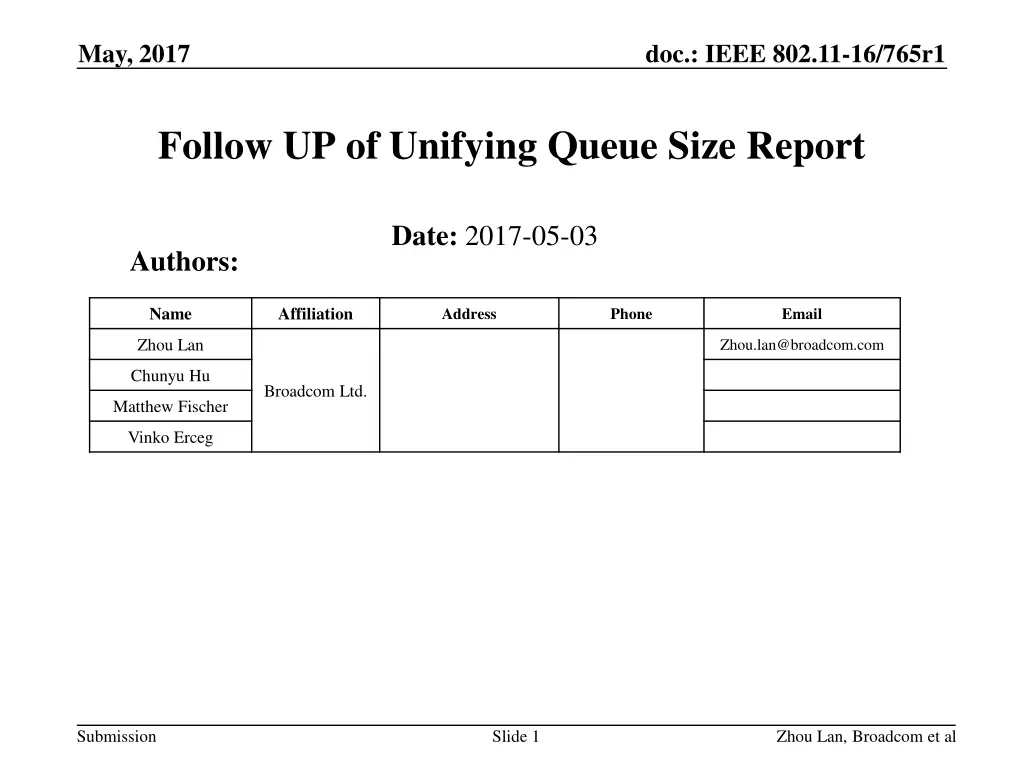
Issues with BSR Control and Queue Size in IEEE 802.11-16/765r1
Explore the challenges and limitations faced in BSR Control for UL MU scheduling in the context of IEEE 802.11-16/765r1. Discusses the impact of incompatibility between QoS control and BSR control, proposes alternatives for efficient UL MU scheduling, and highlights concerns regarding queue size scalability and the support for 256 BA agreements.
Download Presentation

Please find below an Image/Link to download the presentation.
The content on the website is provided AS IS for your information and personal use only. It may not be sold, licensed, or shared on other websites without obtaining consent from the author. If you encounter any issues during the download, it is possible that the publisher has removed the file from their server.
You are allowed to download the files provided on this website for personal or commercial use, subject to the condition that they are used lawfully. All files are the property of their respective owners.
The content on the website is provided AS IS for your information and personal use only. It may not be sold, licensed, or shared on other websites without obtaining consent from the author.
E N D
Presentation Transcript
May, 2017 doc.: IEEE 802.11-16/765r1 Follow UP of Unifying Queue Size Report Date: 2017-05-03 Authors: Name Affiliation Address Phone Email Zhou Lan Zhou.lan@broadcom.com Chunyu Hu Broadcom Ltd. Matthew Fischer Vinko Erceg Submission Slide 1 Zhou Lan, Broadcom et al
doc.: IEEE 802.11-16/765r1 Abstract TGax spec. defines two mechanisms for buffer status report to assist UL MU scheduling. QoS Control and BSR Control This contribution discusses the problems of BSR Control from the perspective of incompatibility with QoS control from the perspective of supporting 11ax specific features for performance improvement 256 BA MCS 1024 QAM TWT This contribution proposes an alternative BSR Control to facilitate 11ax UL MU scheduling Submission Zhou Lan, Broadcom et al Slide 2
doc.: IEEE 802.11-16/765r1 Comments received What is the limitation of the per AC based BSR Control to support 256 BA? What is the concern on scaling factor bigger than 16k octets for TID based Queue Size Report? How does the incompatibility of QoS Control and BSR Control affect the scheduling? Do we have other options instead of replacing per AC based Queue Size Report? Submission Zhou Lan, Broadcom et al Slide 3
doc.: IEEE 802.11-16/765r1 Problem of Supporting 256 BA Queue Size High and Queue Size All in BSR Control is limited in size of 4.1M octets with 1.6K octets scaling factor No reserved bits to further extend the range To support 2 TIDs with 256 BA agreement, Queue Size High needs to indicate at least 6M octets. The maximum MPDU size is 11454 octets To support 256 BA, need 11454*256 = 2932224 octets Queue Size All subfield fails to support more than 2 AC that has TID with 256 BA Submission Zhou Lan, Broadcom et al Slide 4
doc.: IEEE 802.11-16/765r1 Consideration of scaling factor Higher scaling factor increases the range of the Queue Size Report, however fails to provide accurate information as input for scheduler Current BSR Control supports 4 scaling factor: 16, 128,1024,16384 What happens if scaling factor is over 16k octets 16 k octets 121.9Mbps @(BW=20 NSS=1) 1.1ms 243.8Mbps@(BW=40 NSS =1) 0.52ms 243.8Mbps@(BW=20 NSS =2) 0.52ms 487.5Mbps@(BW=40 NSS =2) 0.26ms 32 k octets 2.2ms 1.04ms 1.04ms 0.52ms 64 k octets 4.4ms 2.08ms 2.08ms 1.02ms Very likely over 1 ms will be wasted or filled with padding due to queue size report with scaling factor bigger than 16k Octets 64k scaling factor may cause the waste of over 300 OFDM symbols 4.4ms/12us = 343 Scaling factor over 32k Octets is not preferred Submission Zhou Lan, Broadcom et al Slide 5
doc.: IEEE 802.11-16/765r1 Another problem of higher scaling factor A big range of Queue Size report will have to use coarse resolution of 64 k Octets UL MU scheduler will have difficulty of deciding the RU allocation based on this coarse resolution 4096000 octets 0 octets 64 000 octets 1024 64 k Octets resolution 2048000 octets 0 octets 64 000 octets 1024 32 k Octets resolution 98% cases will use 64 k Octet resolution Submission Zhou Lan, Broadcom et al Slide 6
doc.: IEEE 802.11-16/765r1 Incompatibility of QoS Control and BSR Control Contribution 0477r0 [1] pointed out the incompatibility issue of supporting two buffer status report mechanisms The Queue Size in QoS Data is reported per TID while Queue Size in BSR A- Control is reported per AC All the BA agreements are established based on per TID info Eventually the per AC Queue size needs to be separately recorded and converted to per TID Queue size In addition, QoS Null frame that has both QoS control and BSR Control present is used for solicited BSR report AP will get confused if the buffer size in the QoS control conflicts with that in the BSR control As a results, most implementation will end up with only using QoS control for UL MU scheduling while ignoring the BSR Control. Providing buffer size info in a different format (i.e. per AC) doesn t provide significant benefit while complicating the implementation and adding extra overhead Submission Zhou Lan, Broadcom et al Slide 7
doc.: IEEE 802.11-16/765r1 Proposal Extend the supported Queue Size of QoS control from 64 768 octets to 1024 K octets as suggested in contribution 0477r0 [1] Use same 2 bit scaling factor as that in BSR control, keep the maximum scaling factor as 16K octets Use 6 bit for queue size Max queue size = 64*16K = 1024K octets B0 B3 TID 4 bits B4 EOSP 1 bit B5 B6 ACK policy 2 bits B7 A-MSDU present 1 bit B8 B9 Scaling factor Queue Size 2 bits B10 B15 6 bits Submission Zhou Lan, Broadcom et al Slide 8
doc.: IEEE 802.11-16/765r1 Proposal (Cont.) Define the per AC Queue size in the BSR Control with per TID Queue size as follow B0 B3 First TID 4 bits B4 Queue Size 8 bits B11 B12 B15 Second TID 4 bits B16 B23 B24 B25 Queue Size 8 bits Scaling factor 2 bits Two per TID queue size fields allow a STA to report each time two TID related queue size with up to 4M octet The QoS control field can be used to report an extra TID with queue size up to 1 M octet These changes together increase the total maximum expressible buffer size from: 2,996,992 Bytes = 2,932,224 + 64,768 to: 9,412,608 Bytes (aka octets) = 1,024,000 + 2 * 256 * 16384 Submission Zhou Lan, Broadcom et al Slide 9
doc.: IEEE 802.11-16/765r1 Straw poll Do you support to Use two bits of Queue size field for scaling factor. The scaling factor follows the same definition of the current BSR Control. Yes No Abstain Submission Zhou Lan, Broadcom et al Slide 10
doc.: IEEE 802.11-16/765r1 Straw poll Do you support to Option 1: Adding a new control ID for per-TID based queue size report as shown in slide 8 and slide 9 Option 2: Replace the current BSR Control field with the proposed new BSR Control field as shown in slide 8 and 9. Option 3: Other solution welcome Yes No Abstain Submission Zhou Lan, Broadcom et al Slide 11
doc.: IEEE 802.11-16/765r1 Straw poll Do you support to Adopt document IEEE 802.11-17/0766r1 as the resolution of CID 8426, 8427 Yes No Abstain Submission Zhou Lan, Broadcom et al Slide 12
doc.: IEEE 802.11-16/765r1 Back up slides Submission Zhou Lan, Broadcom et al Slide 13
doc.: IEEE 802.11-16/765r1 Problem statement (cont.) Current BSR Control in Draft spec 1.2 is limited in size of 4.1M octets with 1.6K octets scaling factor in both Queue Size High and Queue Size All fields No reserved bits to further extend the range Per baseline spec, the maximum MPDU size is 11454 octets, in order to support 256 BA window the required buffer size is 11454*256 = 2932224 octets If the STA supports 2 TIDs with 256 BA agreement, 3*2= 6 M octets is needed in the Queue Size High field If the STA supports two ACs each supporting two TIDs with 256 BA agreement, 12 M octets is needed in the Queue Size All field The current BSR Control can not support the above use cases and there is no reserved bits available for further range extension Submission Zhou Lan, Broadcom et al Slide 14
doc.: IEEE 802.11-16/765r1 Problem statement Contribution 0477r0 [1] pointed out the incompatibility issue of supporting two buffer status report mechanisms The Queue Size in QoS Data is reported per TID while Queue Size in BSR A- Control is reported per AC All the BA agreements are established based on per TID info Eventually the per AC Queue size needs to be separately recorded and converted to per TID Queue size In addition, QoS Null frame that has both QoS control and BSR Control present is used for solicited BSR report AP will get confused if the buffer size in the QoS control conflicts with that in the BSR control As a results, most implementation will end up with only using QoS control for UL MU scheduling while ignoring the BSR Control. Providing buffer size info in a different format (i.e. per AC) doesn t provide significant benefit while complicating the implementation and adding extra overhead Submission Zhou Lan, Broadcom et al Slide 15
doc.: IEEE 802.11-16/765r1 Problem statement (cont.) The current BSR Control fails to support Multi-TID aggregation due to similar reasoning as presented in the previous slide Draft spec. 1.2 support Multi-TID aggregation with 256 BA window The current BSR Control will not be able to support Multi-TID aggregation with more than two TID supporting 256 BA window In order to support TWT operation, a STA may need to buffer UL data to wait for the next service period Assuming the STA is scheduled in a 996 RU with Nss =1 and MCS 11 for 1024QAM Assuming the STA is under a TWT agreement of 5ms wake interval 4M Octets total Queue size for all AC may not be sufficient to support TWT operation Submission Zhou Lan, Broadcom et al Slide 16

